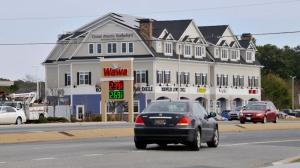Sussex council adopts new commercial districts
Starting July 1, Sussex County developers and property owners will have seven choices when they seek to obtain commercial zoning. The most-used commercial districts – CR-1 and B-1 – will become closed districts and will no longer be available.
County council unanimously adopted the new zoning districts at its Feb. 27 meeting.
“In the development world, there has been a lot of interest in this,” said assistant county attorney Vince Robertson. “There's been a lot of positive feedback.”
“We now have some predictability in what we do in commercial zones,” said Councilman George Cole, R-Ocean View.
Under the current CR-1, commercial-residential zone, hundreds of uses are permitted. As the first major overhaul of county commercial zoning, the new districts are fine-tuned with more specific permitted uses and regulations on setbacks, parcel size and floor square footage. Existing residential districts are not affected by the changes.
Robertson said the final draft reflects input from the public and county staff.
Robertson said developers needed some lead time to know which path to follow as the current CR-1 and B-1 would become closed districts as of July 1. He said any commercial zoning application in the pipeline until that date would be considered under the old zoning code. “But they could get in the queue under the new districts if they wanted to,” he said.
But, he said, public hearings would have to occur after July 1 to take advantage of the new zoning districts.
Sussex County Planning and Zoning Director Janelle Cornwell said because of scheduling, any new applications filed starting in March would not have public hearings scheduled until after July 1. “Some applicants are already in, and they want to wait,” she said.
The new commercial districts are as follows:
B-2, business community, 51 permitted uses. For office, retail and personal service uses to serve a relatively small area near rural, low- or medium-density neighborhoods. Retail floor space is limited to 30,000 square feet or less with a minimum of 3,000 square feet and a maximum of 3-acre parcels.
B-3, business commercial, 23 permitted uses. For business research and business park uses with no outside sales and no minimum or maximum parcel or square-footage requirements.
C-2, medium commercial, 50 permitted uses. For a variety of retail, professional and services businesses near arterial and collector streets with no outside sales or storage. Retail floor space is limited to 75,000 square feet or less.
C-3, heavy commercial, 60 permitted uses. For large-scale, auto-oriented retail and services businesses including RV and boat sales. Maximum floor area for a single building is 150,000 square feet with no minimum or maximum parcel size.
C-4, planned commercial, 66 permitted uses. For planned large-scale commercial, retail and mixed-use development. The district is the only one with residential included as a permitted use. In addition, site plans are required as part of the application/public hearing process. Residential uses include single family, multifamily, town houses and duplexes and are restricted to no more than 20 percent of the total project square footage. The minimum parcel size is 3 acres with no maximum lot size.
C-5, service, limited manufacturing, 27 uses. For small-scale light industrial, wholesale and personal service uses with a retail component. Minimum floor space is 15,000 square feet.
I-1, institutional, 32 permitted uses. For a variety of government, medical, educational uses with no lot-size restrictions.
If a requested commercial use is not specifically listed in the ordinance, the planning and zoning commission has authority to allow it as an application is filed.
Several uses are permitted in several districts:
Seven districts – Public safety facilities; churches; communication towers; utility service facilities.
Six districts – Business services; professional offices; early childhood centers; medical clinics; fitness/wellness centers; government buildings; parks.
Five districts – Banks; restaurants up to 7,500 square feet; retail 3,500 to 7,500 square feet or less; assisted living, extended, intermediate and long-term care centers; self-storage units; museums; community centers.
Four districts – Day-care centers; pharmacies; retail 7,501 to 35,000 square feet; indoor recreation centers; surgical centers; tech centers; animal hospitals or veterinarian clinics; independent-living facilities; indoor recreation centers; small and large day-care centers; clubs and lodges.
Temporary vendor stands – including food trucks – are permitted in six districts.
Wineries, breweries and distilleries under 7,500 square feet are permitted in five districts.
























































